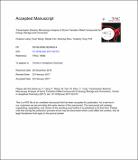Transmission electron microscopy analysis of some transition metal compounds for energy storage and conversion
Abstract
Recently, transition metal compounds (TMCs) have been employed as high-performance electrode materials for lithium ion batteries (LIBs) and supercapacitors (SCs) owing to their high specific capacities, high electrical conductivity, and high chemical and thermal stability. While the characterization of electrochemical properties of TMC anodes is well developed, new challenges arise in understanding the structure-property relationships. Transmission electron microscopy (TEM) is a powerful tool for studying microstructural characteristics. With TEM and related techniques, fundamental understanding of how the microstructures affect the properties of the TMC nanostructured anodes can be improved. In this article, the application of TEM in characterization of some typical TMC anode materials optimized through structural engineering, elemental doping, surface modification, defect-control engineering, morphological control, etc. is reviewed. Emphasis is given on analyzing the microstructures, including surface structures, various defects, local chemical compositions and valence states of transition metals, aimed at illustrating a structure-property relationship. The contribution and future development of the TEM techniques to elucidation of the electrochemical properties of the TMC anodes are highlighted.
Citation
Liang , C , Wang , F , Fan , W , Zhou , W & Tong , Y 2017 , ' Transmission electron microscopy analysis of some transition metal compounds for energy storage and conversion ' , TrAC Trends in Analytical Chemistry , vol. 90 , pp. 62-79 . https://doi.org/10.1016/j.trac.2017.02.010
Publication
TrAC Trends in Analytical Chemistry
Status
Peer reviewed
ISSN
0165-9936Type
Journal item
Description
This work was preliminarily supported by the National Key Research Program of China (2016YFA0202604), the Natural Science Foundation of China (21476271), NSFC-RGC (21461162003) and Natural Science Foundation (2014KTSCX004 and 2014A030308012) of Guangdong Province, China.Collections
Items in the St Andrews Research Repository are protected by copyright, with all rights reserved, unless otherwise indicated.

